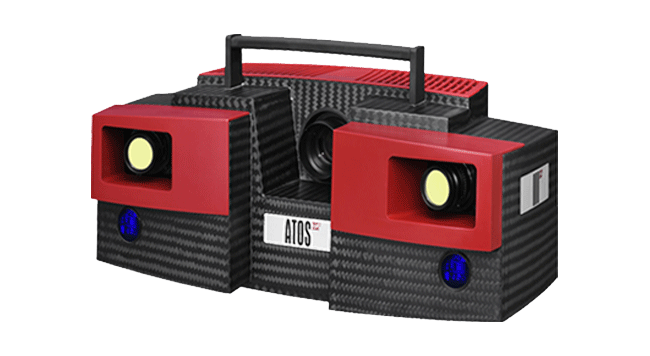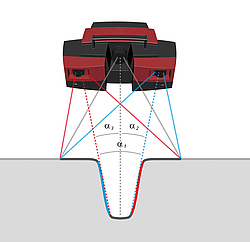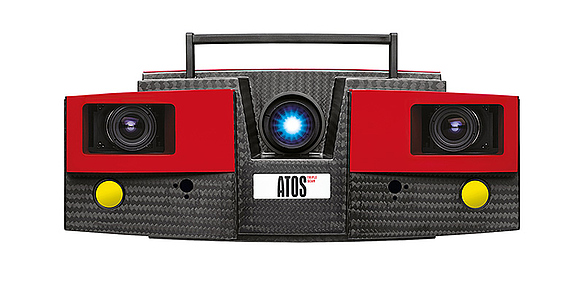Customer login
Not registered yet?
Register now! It is easy and done in 1 minute and gives you access to special discounts and much more!
ATOS Triple Scan in Use
Automated 3D metrology
Technology
Triple Scan Principle
Self-monitoring system
The right combination of hardware and software
Virtual Measuring Room
Mobile metrology

Industrial Optical 3D Digitizer
ATOS Triple Scan is a high resolution, optical digitizer that delivers rapid and precise three-dimensional measuring data for the optimization of design processes, thereby improving industrial production processes. ATOS sensors are used in many industries for the inspection of parts such as sheet metals, tools and dies, turbine blades, prototypes and injectionmolded and pressure die-cast parts.


ATOS Triple Scan in Use
Automated 3D metrology
In the standardized measuring machine ATOS ScanBox, ATOS Triple Scan is used for fully automated measuring and inspection of parts. The ATOS ScanBox is a complete optical 3D measuring machine that was developed by GOM for an efficient quality control in production and manufacturing processes. In the ATOS ScanBox models of series 5, 6, 7 and 8, ATOS Triple Scan can be extended with a Plus Box photogrammetry add-on. This allows bigger components or multiple parts to be measured simultaneously.
Mobile 3D metrology
Manually, ATOS Triple Scan is used with a studio stand or a desk stand. For the semi-automatic use, a 3-axis motorization kit, including a lift module for the sensor and a Tilt and Swivel Unit for the fixture, is available. Mobile rotation tables enable simple automated measurement of small to medium objects. Furthermore the GOM Touch Probe allows point-based measurement of areas that are difficult to access optically.

ATOS Triple Scan Technology
Precise fringe patterns are projected onto the surface of the object and are recorded by two cameras, based on the stereo camera principle. As the beam paths of both cameras and the projector are calibrated in advance, 3D surface points from three different ray intersections can be calculated: Visual beam camera / camera, visual beam camera on left / projected beam projector and camera on right / projected beam projector. This automatic principle offers advantages in measuring reflective surfaces and objects with indentations.
Triple Scan Technology
Together with both cameras, the projection unit operates according to the triple scan principle. During the measurement, precise fringe patterns are projected onto the surface of the object and are recorded by two cameras, based on the stereo camera principle. This automatic principle offers advantages in measuring reflective surfaces or objects with complex indentations.

Blue Light Technology
The projection unit of the ATOS Triple Scan system is based on Blue Light Technology. Since the sensor works with narrow-band blue light, interfering ambient light can be filtered during image acquisition. Due to its powerful light source, short measuring times can be achieved.

ATOS Plus
In GOM’s automated measuring machines, ATOS sensors can be operated together with the Plus Box. The latter is a photogrammetric add-on sensor which can be directly attached to the ATOS system. This enables fully automated measuring of reference point markers with a deviation of 3 μm to 30 μm. These reference point markers create a 3D volume, into which the detailed individual measurements of the ATOS sensors are transformed automatically. This is how the overall accuracy of the overarching photogrammetric measurement is achieved.
Self-monitoring system
The sensor recognizes changing ambient conditions during operation and is able to compensate these changes. To do so, the software of the sensor is continuously monitoring the calibration status, the transformation accuracy, environmental changes and part movements to ensure the quality of the measuring data.

Virtual Measuring Room
The virtual measuring room (VMR) is the central control station and measurement planning software for all elements of the ATOS measuring cells. It offers the functional representation of a real measurement environment in a virtual simulation. Due to the VMR, the user can work with the system without the requirement for specific robot programming skills. All robot movements are simulated and checked for safety before being performed in the virtual measuring room.

Parametric Inspection
The ATOS Professional evaluation software provides all necessary tools for a comprehensive analysis of parts and components. Using parametric inspection, all actions and evaluation steps are completely traceable and interlinked. Thus, changes and modifications are possible at any time.
Industrial advantages for industrial processes
The ATOS Professional evaluation software provides all necessary tools for a comprehensive analysis of parts and components. Using parametric inspection, all actions and evaluation steps are completely traceable and interlinked. Thus, changes and modifications are possible at any time.
The ATOS 3D Digitizer is an accurate and cost-effective solution in a number of different application areas including
ATOS 3D Digitizers have been produced and constantly developed since 1995 and with more than 2500 installations in measurement and analysis rooms as well as factory and production halls worldwide, the ATOS has been for a long time an accepted measurement method beside the mechanical measurement machines
The ATOS sensor combines high data quality in short measurement time with flexibility and stability for industrial environments
Universal process safety
The ATOS 3D Digitizer is established in industrial process chains. The integration of ATOS in industrial development and production processes helps:
© 2020. APM Technologies
Copyright © 2020. All rights reserved





